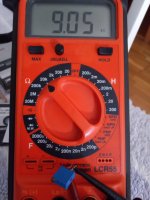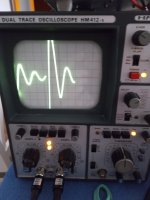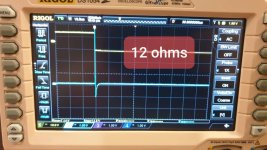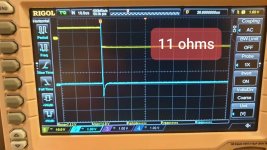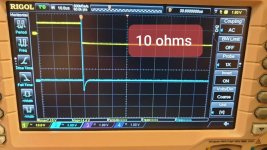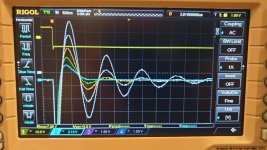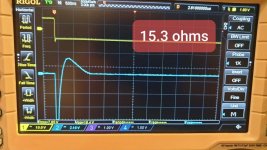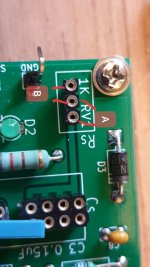The secondary is 150 VAC, I use standard values for snuber caps 10nF & 150nF with Quasimodo jig.
Hi Guys,
Just double checking.
I have a transformer with multiple secondary windings.
2 x 45v AC
1 x 18v AC
1 x 12v AC
I am using the 45v dual secondary windings as per the 4th row example in the Quasimodo documentation to drive my amplifier.
I have dual snubber network and dual bridge rectifier.
I am also using the 12v winding for my speaker protection.
I am not use the 18v winding and its currently open circuit.
I understand that to establish the correct value for Rs I need to short the primary winding and the other 45v secondary winding.
My question is, What do I do with the other 12v and 18v secondary windings?
I'm assuming that I need to sort them . If I could just get some confirmation that would be great.
Just double checking.
I have a transformer with multiple secondary windings.
2 x 45v AC
1 x 18v AC
1 x 12v AC
I am using the 45v dual secondary windings as per the 4th row example in the Quasimodo documentation to drive my amplifier.
I have dual snubber network and dual bridge rectifier.
I am also using the 12v winding for my speaker protection.
I am not use the 18v winding and its currently open circuit.
I understand that to establish the correct value for Rs I need to short the primary winding and the other 45v secondary winding.
My question is, What do I do with the other 12v and 18v secondary windings?
I'm assuming that I need to sort them . If I could just get some confirmation that would be great.
Hi Stuart,
as far as I understand the scenario, your thinking seems correct to me: All windings except the one winding under test need to be shorted. If windings stay unused lateron is not relevant for the Rs optimising method, because you only want to determine the behavior of the winding under test without influence of other windings (therefore they are shorted).
Kind Greetings,
Winfried
as far as I understand the scenario, your thinking seems correct to me: All windings except the one winding under test need to be shorted. If windings stay unused lateron is not relevant for the Rs optimising method, because you only want to determine the behavior of the winding under test without influence of other windings (therefore they are shorted).
Kind Greetings,
Winfried
Yes, short them all. It is the leakage inductance that you are 'tuning', and the only efficient way to do it is one winding at a time.
Cheers
Cheers
Stuart,
none of your posted options is optimal. There is a really well put together PDF document in this thread describing the method and explaining the optimum. As a shortcut go to posting 001 to see a picture showing the optimisation path. Once you have reviewed that you will be absolutely clear which is the optimal decay curve and tuning Rs becomes a "no brainer"!
Regards,
Winfried
none of your posted options is optimal. There is a really well put together PDF document in this thread describing the method and explaining the optimum. As a shortcut go to posting 001 to see a picture showing the optimisation path. Once you have reviewed that you will be absolutely clear which is the optimal decay curve and tuning Rs becomes a "no brainer"!

Regards,
Winfried
Last edited:
Hello Stuart,
your 15.3 Ohms value measurement looks optimal to me, the value itself matches my experience ballpark when using Cx=10nF and Cs=150nF.
Regards,
Winfried
your 15.3 Ohms value measurement looks optimal to me, the value itself matches my experience ballpark when using Cx=10nF and Cs=150nF.
Regards,
Winfried
Thanks for your helpHello Stuart,
your 15.3 Ohms value measurement looks optimal to me, the value itself matches my experience ballpark when using Cx=10nF and Cs=150nF.
Regards,
Winfried
Al lot of great info here...does anyone have a suggested for values on a Hammond 1182u24, building my first diy PSU v3 and F5 turbo mono blocks...any insight is appreciated. Looking for Cx, Cs and Rs, noting I am running 120vac on the line side, 24v secondaries on the transformer.I don't own a scope...yet...thanks.


Hi Scott,
Welcome to the forum.
Could you possibly borrow one? Or take the Hammond, some alligator clips, and your Quasimodo over to a friend's house who does have a 'scope?
The only other possibility I can think of, might be to scan the Quasimodo-Results-Only thread for someone reporting results for that transformer -- or a very similar one.
Many, many successful audio projects have been built with little or no consideration accorded the issue that Quasimodo addresses. Odds are good that your F5's will sound fine without the snubbers. Then, when a 'scope magically appears on your front porch, you can implement them. It'll only take a few minutes -- an easy retro-fit.😉
The whole point of Quasimodo is a math-free, visual technique that yields an optimum solution for the exact combination of transformer and rectifiers in your equipment -- even if those components are out of spec! It begs a 'scope.
Regards
Welcome to the forum.
Could you possibly borrow one? Or take the Hammond, some alligator clips, and your Quasimodo over to a friend's house who does have a 'scope?
The only other possibility I can think of, might be to scan the Quasimodo-Results-Only thread for someone reporting results for that transformer -- or a very similar one.
Many, many successful audio projects have been built with little or no consideration accorded the issue that Quasimodo addresses. Odds are good that your F5's will sound fine without the snubbers. Then, when a 'scope magically appears on your front porch, you can implement them. It'll only take a few minutes -- an easy retro-fit.😉
The whole point of Quasimodo is a math-free, visual technique that yields an optimum solution for the exact combination of transformer and rectifiers in your equipment -- even if those components are out of spec! It begs a 'scope.
Regards
- Home
- Amplifiers
- Power Supplies
- Simple, no-math transformer snubber using Quasimodo test-jig
